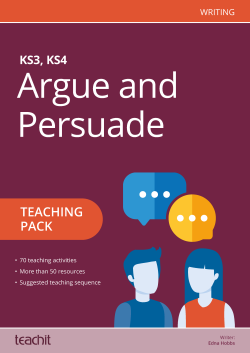Argue and persuade pack
A KS3 pack designed to help students understand and identify persuasive techniques and apply them to their own writing.
The pack is split into sections and features a range of practical and engaging activities aimed at familiarising students with persuasive writing, including: speeches, letters and leaflets, articles, argumentative writing, revision and exam preparation.
What's included?
- KS3 curriculum assessment objective map
- lesson plans and ideas along with tailor-made resources.
What's inside?
Each lesson plan contains detailed teaching notes with:
- Suggested starter activities
- Suggested main activities
- Suggested plenary activities
- Suggested additional creative activities
Assessment Objective map (pages ii-v)
Introduction - summary of the pack (page 1)
Teaching notes and lesson plans (pages 2-14)
- Route through – part one: familiarising students with persuasive writing
- Route through – part two: speeches
- Route through – part three: letters and leaflets
- Route through – part four: articles
- Route through – part five: focusing on argumentative writing
- Route through – part six: revision and exam preparation
Teaching resources and activities for persuasive and argumentative writing (pages 15-135)
- Persuasive role play
- Persuading your parents
- Can you sell a house?
- Flog that house!
- Planet perfect!
- Save my dog!
- Persuasive techniques bingo
- What's your learning style?
- Winston Churchill speech excerpt
- Comparing persuasive speeches
- Cats are better than dogs
- England riots persuasive speech analysis
- Writing a speech
- Young people's council meeting
- Rewriting for audience and purpose
- Analysing a leaflet
- Kick-start discussion slides
- Recipe for a formal letter
- Rat o'burger
- 'Send a cow' practice questions and answers
- Preparation of a leaflet
- Theme park persuasive writing leaflet
- Self-assessment review
- Writing to persuade checklist
- Fact or opinion
- Tabloid or broadsheet?
- Newspaper bias
- Lead articles
- Analysing an opinion article
- Writing a feature article
- Why use quotations?
- How to use quotations effectively
- Using a newspaper as a stimulus
- Editorial decisions
- Summarise that!
- Categorising connectives
- Hinges, bolts and sealers
- Effective introductions
- Building an argument
- Writing for different purposes
- The man on the wall story problem
- To argue or persuade
- Literacy placemat
- Speed dating revision
- Writing revision fan
- Top grade persuasion
- All fun and games revision
- Card template
- Domino template
- Fishing template
- Analysing persuasive texts
- Room 101
This is a sample student activity on persuasive techniques:
Persuasive techniques bingo
Rules: read out each question and its number, and ask pupils to write the question number next to the definition that they think is correct (see bingo cards).
1.Speaking to the reader in a friendly way (chatty style).
2.Questions that don’t require an answer (rhetorical questions).
3.Demonstrating differences in viewpoint (contrasts).
4.Destroy the point of view of the opposing argument (criticise the opposite opinion).
5.Using words like ‘we’, ‘us’ and ‘you’ to make the writing more appealing (personal pronouns).
6.Making the reader surprised or horrified (shock tactics).
7.Being over-the-top to get a point across (exaggeration/hyperbole).
8.Pictures or illustrations that are meant to arouse your emotions (emotive pictures).
9.Make the reader feel bad about something (play on the reader’s guilt).
10.Making points easy to follow on the page (short sentences/paragraphs).
11.Light-hearted expression of a viewpoint (humour).
12.Support a point with the views of a professional (quote a reliable source).
13.Words that arouse emotion (emotive words).
14.Numbers/graphs which provide convincing information (statistics).
15.Three phrases or describing words used to emphasise a point (clusters of three).
16.Using words like ‘I urge’ or ‘I demand’ for emphasis (forceful phrases).
17.Thought provoking pictures in your mind (imagery).
18.Saying the same word or phrase more than once for emphasis (repetition).
19.Make the reader feel sorry for something or someone (play on the reader’s sympathy).
20.Similes and metaphors adding colour to the writing (figures of speech).
21.Words that stick in your mind (catchy words or phrases).
22.Little stories to illustrate a point (anecdotes).
All reviews
Have you used this resource?
Review this resource25/06/2021
07/07/2020
28/05/2020
24/04/2020
27/10/2019
18/10/2019
21/07/2019
02/02/2019
29/08/2018
I've just had a look at some tips .It seems to me I'll be able to use quite a lot of interesting activities
22/07/2017

